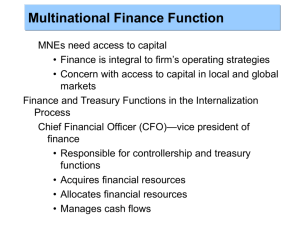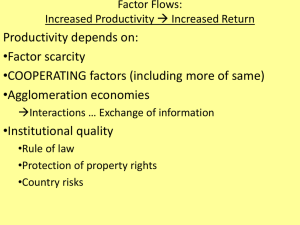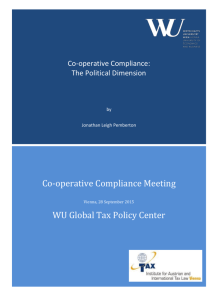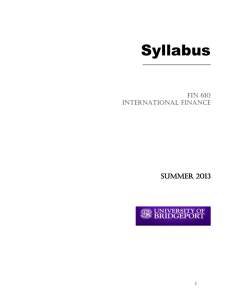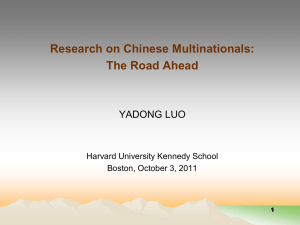International Expansion of Emerging Market Multinationals: An Integrated Perspective Michael Yi Cao
advertisement
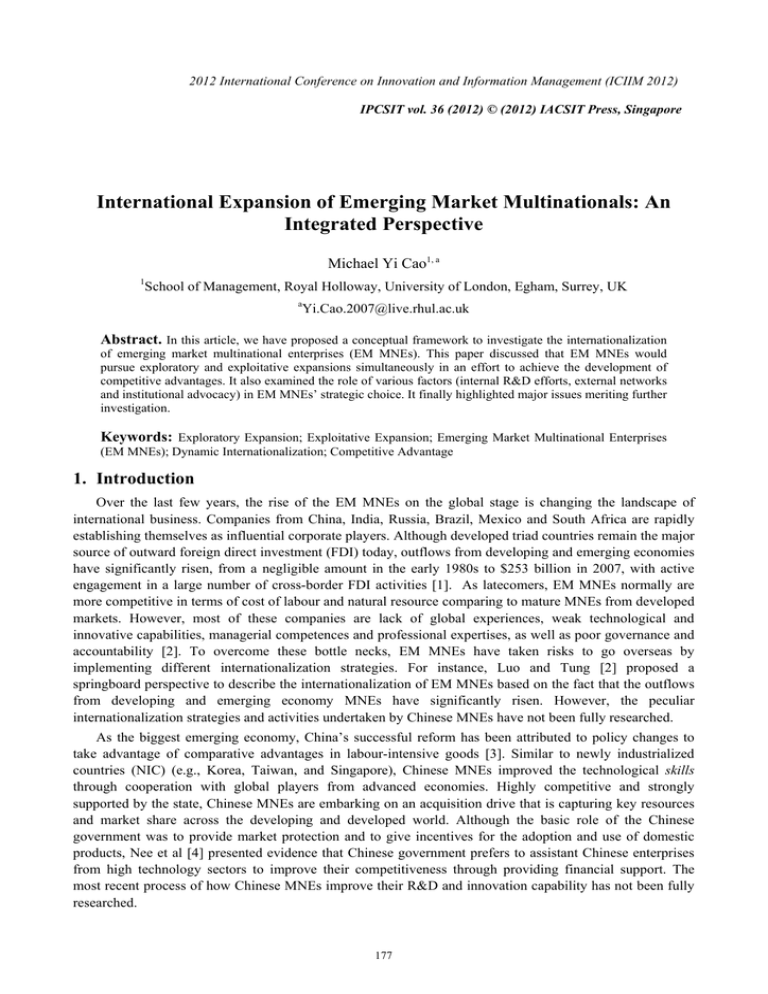
2012 International Conference on Innovation and Information Management (ICIIM 2012) IPCSIT vol. 36 (2012) © (2012) IACSIT Press, Singapore International Expansion of Emerging Market Multinationals: An Integrated Perspective Michael Yi Cao1, a 1 School of Management, Royal Holloway, University of London, Egham, Surrey, UK a Yi.Cao.2007@live.rhul.ac.uk Abstract. In this article, we have proposed a conceptual framework to investigate the internationalization of emerging market multinational enterprises (EM MNEs). This paper discussed that EM MNEs would pursue exploratory and exploitative expansions simultaneously in an effort to achieve the development of competitive advantages. It also examined the role of various factors (internal R&D efforts, external networks and institutional advocacy) in EM MNEs’ strategic choice. It finally highlighted major issues meriting further investigation. Keywords: Exploratory Expansion; Exploitative Expansion; Emerging Market Multinational Enterprises (EM MNEs); Dynamic Internationalization; Competitive Advantage 1. Introduction Over the last few years, the rise of the EM MNEs on the global stage is changing the landscape of international business. Companies from China, India, Russia, Brazil, Mexico and South Africa are rapidly establishing themselves as influential corporate players. Although developed triad countries remain the major source of outward foreign direct investment (FDI) today, outflows from developing and emerging economies have significantly risen, from a negligible amount in the early 1980s to $253 billion in 2007, with active engagement in a large number of cross-border FDI activities [1]. As latecomers, EM MNEs normally are more competitive in terms of cost of labour and natural resource comparing to mature MNEs from developed markets. However, most of these companies are lack of global experiences, weak technological and innovative capabilities, managerial competences and professional expertises, as well as poor governance and accountability [2]. To overcome these bottle necks, EM MNEs have taken risks to go overseas by implementing different internationalization strategies. For instance, Luo and Tung [2] proposed a springboard perspective to describe the internationalization of EM MNEs based on the fact that the outflows from developing and emerging economy MNEs have significantly risen. However, the peculiar internationalization strategies and activities undertaken by Chinese MNEs have not been fully researched. As the biggest emerging economy, China’s successful reform has been attributed to policy changes to take advantage of comparative advantages in labour-intensive goods [3]. Similar to newly industrialized countries (NIC) (e.g., Korea, Taiwan, and Singapore), Chinese MNEs improved the technological skills through cooperation with global players from advanced economies. Highly competitive and strongly supported by the state, Chinese MNEs are embarking on an acquisition drive that is capturing key resources and market share across the developing and developed world. Although the basic role of the Chinese government was to provide market protection and to give incentives for the adoption and use of domestic products, Nee et al [4] presented evidence that Chinese government prefers to assistant Chinese enterprises from high technology sectors to improve their competitiveness through providing financial support. The most recent process of how Chinese MNEs improve their R&D and innovation capability has not been fully researched. 177 Following Luo and Tung’s [2] research on EM MNEs’ international expansion, this paper draws attention to the rise of the R&D strategy and technological capability of the Chinese MNEs. Thus, this paper aims to propose a conceptual framework from an integrated perspective by reviewing previous literature. The outcome of this paper has important policy and managerial implications not only for China, but also for other emerging economies. 2. EM MNEs’ Internationalization Strategy: An Integrated Framework In this paper, EM MNEs are defined as international companies that originated from emerging markets and are engaged in outward FDI, where they exercise effective control and undertake value-adding activities in one or more foreign countries [2]. Rapid growth and remarkable transformation of EM MNEs in recent years have made them more competitive globally against their rivals at home and abroad. Due to the lack of assets including advanced technology, R&D facilities, talented human capital, managerial expertise, and natural resources, EM MNEs were triggered to acquire these critical resources through international expansion. They differ sharply from advanced market MNEs, which generally leverage and exploit their ownership-specific competitive advantages in foreign countries [5]. In this paper, we propose that Chinese MNEs pursues dynamic internationalization strategy, that is, simultaneous implementation of exploratory and exploitative expansion. Here, exploratory expansion refers to firms move abroad to acquire new assets which are hard to secure in their home countries; exploitative expansion refers to firms leverages the existing advantages to invest in other countries with the aim of achieving market success. Concerning exploratory expansion, firms are likely to use cross-border acquisition. For exploitative expansion, firms use strategic alliance, joint venture, or/and licensing. However, internationalization is high risks and uncertainties. Thus, we argue that Chinese MNEs are dynamically implementing both internationalization strategies to develop their competitive advantages in the global market. We also hypothesize that dynamic internationalization strategy is affected by internal R&D efforts, external networks and institutional advocacy. 3. Internal R&D Efforts It is widely recognized that in-house R&D capacity is positively related to firm innovation. The internal R&D level represents a firm’s ability to develop and improve its new products. It also embraces the ability to internalize technology created by others and modify it to fit the firm’s specific applications, processes and routines. In general, firms will devote more R&D resource when they are sure of the linkage between more R&D input and more R&D outputs [6]. We focus on two dimensions of in-house R&D efforts: R&D personnel and funding. With talented technical employees, firms from emerging markets can quickly identify what new knowledge their firm needs and effectively absorb the new knowledge from outside. In addition, conducting R&D is the money-consuming activity for a firm. Without sufficient financial subsidizations, it is difficult for firms to engage in R&D activities. From this viewpoint, EM MNEs may need to accumulate R&D personnel and funding through market success. Arguably, due to lack of sufficient R&D personnel and funding, EM MNEs may use a mixed expansion strategy, which is like ‘learning by doing’. It is likely that they use exploitative expansions to probe the global market, and then aggressively acquire their target via exploratory expansions. 4. External Networks For EM MNEs, networks that lead to an increasing interaction between various actors represent an organizational response to the complexity of technology development. Many scholars have stressed the importance of establishing inter-organizational collaborations with external partners, and have argued that boundary spanning activities are essential to successful knowledge flows, which subsequently affect a firm’s innovation success [7]. In this paper, we focus on collaborations with research organizations (e.g. universities, colleges, technical institutes and research institutions) and foreign MNCs in China. Firstly, through cooperating with research organizations, firms can tap into advanced scientific and technological knowledge pools, thus strengthening their in-house R&D capacities. Next, it also should be noted that business ties with foreign MNC partners can be seen as an important means for EM MNEs overcome their deficiencies in knowledge about global market. strong business ties also support the exchange of high-quality 178 and diverse information that helps local managers gain insights in learning sophisticated manufacturing techniques and understanding new product offerings, resulting in more efficient and effective knowledge absorption [8]. It can be argued that EM MNEs are likely to leapfrog to overseas market for acquiring more advanced technological knowledge with strong ties with their partners. 5. Institutional Advocacy Peng and Heath [9] argue that firm’s strategic choice is inherently affected by the institutional framework. This paper focused on two dimensions: government support and FDI legitimization. First, government can grant a firm access to favourable financial resources to conduct trial-and-error experimentation and exert influence on managers in gaining access to other knowledge resources [8]. Government support makes a significant impact on the process of technological learning through both industrial, trade, finance, and technology policies, which affect a firm’s interactions with the international community by regulating the inflow of foreign technology. They affect the firm’s interactions with the domestic community by influencing the availability and efficacy of local supporting institutions and the quality of educational institutions. And they affect the firms’ interaction with the market environment by shaping industrial organizations. These policies thus affect directly or indirectly the process of the technology development of the firm. In addition, FDI legitimization captures the extent to which foreign invests is well accepted by a variety of constituencies in the host country [10]. Gaining legitimacy is important for foreign firms because they generally suffer from the liability of foreignness [11]. In this regard, EM MNEs should consider which outward FDI activities can help them build strong legitimization in the host countries. 6. Discussion In general, EM MNEs are facing the problem of lacking advanced technology which put them into a less competitive position in the competitive global market. As part of their internationalization strategy, technological catch-up will reduce their gap between their competitors form developed markets and help them to develop their independent R&D system. They have to find innovative ways to make space for themselves in markets that were already crowded with giant competitors, for instance, finding new ways to “complement” the strategies of the incumbents, such as through licensing new technologies, to forming joint ventures and strategic alliances. It is plausible that it was through the implementation of these “complementary” strategies that latecomers were able to win a place in the emergent global economy, not on the basis of their existing strengths, but on the basis of their capacity to leverage resources from the strengths of others, through making international connections [12]. These internationalization strategies, designed to enhance firms’ resource base rather than to exploit existing assets, represent a fundamental departure in thinking by firms about what “globalizing” means and how it can be accomplished. We, here, tried to challenge this traditional thinking about EM MNEs’ expansion strategies. It should be noted that many Chinese MNEs invested in south-east Asia to absorb their excess production capacity for leveraging their cost-effective manufacturing capabilities [2]. Also, many Chinese MNEs invested in Africa to exploit their advantages in terms of the labour cost and comparative advanced technologies. Thus, it can be proposed that the key for success of EM MNEs is formulating the ‘fit’ internationalization strategy rather than homogeneous one. Another issue raised in this paper is the role of institutional factors, especially governmental support. Here, we look into one of leading Chinese MNEs – Huawei Technologies in order to find out to what extent government support will affect firms formulate their strategic choices from practical world. Huawei’s internationalization process benefits heavily from government support and protection. In the early 1990s, the telecom products in Chinese market were mostly monopolized by foreign enterprises, with only few emerging domestic players such as Huawei, ZTE and Datang [13]. Therefore, in order to cope with competition from foreign enterprises and enhance local telecom enterprises’ competency before China’s entry into the WTO, Ministry of Information Industry (MII), the government bureaucrat controlling China’s telecom industry, issued a series of policies and measures to support domestic telecom enterprises and protect China’s telecom market. Since 1997, the Ministry of Posts and Telecommunications (MPT) had 179 organized coordinating conferences every year with the Administrative Bureaus of Post and Telecommunication. Through these conferences, the MPT encouraged the Administrative Bureaus of Post and Telecommunication to purchase indigenous equipment, if the equipment were suitable in character and proper in price. During the first conference, contracts for more than 5 million lines were signed, and at last more than 7 million lines digital automatic exchange were sold. In the second coordinating conference, contracts for 17 million lines digital automatic switch were agreed on and 18 million lines were sold eventually. Under the encouragement of the People’s Bank of China, the China Construction Bank supplied Huawei buyer credit 3.85 billion RMB, which was 45% of the bank’s total buyer credit in 1998. Affected by the coordinating conferences and financial support, since 1998 the market share of the indigenous firms increased rapidly, and they became the main suppliers in the domestic market. To improve the R&D capability of Chinese telecom enterprises, the governments also played a significant role in helping to bring about technology cooperation and strategic alliances between Huawei and foreign telecom giants such as Motorola, Siemens, Nokia, etc. Chinese government also provided soft loan for Huawei’s international operation, for example, two state owned banks - The Export-Import Bank of China (China Eximbank) and China Development Bank (CDB) provided Huawei 600 million USD (Huawei News, 8 April 2004) and 10 billion USD (MOFCOM News, 15 March 2005) credit respectively in 2004. Under governments’ meticulous care and support, Huawei quickly grew from a weak domestic private enterprise into a multinational telecom enterprise with international competency. Huawei also benefited from Chinese government policies including industrial policy, “go global” policy and even foreign policy. Nee et al [4] presented evidence that Chinese government prefers to assistant Chinese enterprises from high technology sectors to improve their competitiveness through providing financial support. As a high technology enterprise, Huawei benefited from the priorities of the access to capital resources, raw materials, and preferential tax policy. In 1999, in the context of huge inflows of FDI into China, the Chinese government launched “Go Global” policy to encourage and support more strong Chinese enterprises to invest overseas in order to improve their competitiveness [14]. Huawei accelerated its catch-up and internationalization process supported by government policy at that time. It is the unique characteristic of Huawei’s internationalization process to carry out internationalization strategic arrangement to according to China’s foreign policy orientation. For instance, Huawei participated in Chinese government’s assistance projects in Africa and Asia. Although most of these projects are non-profitable, Huawei established a closer tie with the government through these projects. More importantly, it entered the markets in those developing countries and set up its brand there. 7. Conclusion In this paper we propose a theoretical framework about EM MNEs’ internationalization strategy (see Figure 1). This paper stands a new angle to look insight into EM MNEs engaging in varying outward FDI activities for compensating their competitive disadvantages. Due to turbulent environment, EM MNEs, especially Chinese MNEs would have to simultaneously implement both exploratory and exploitative expansions to obtain critical strategic assets. Unlike MNEs from developed or newly industrialized economies, EM MNEs may need to strengthen internal R&D efforts and strengthen the connections with both research organizations and foreign MNC partners in their home country. Finally, this paper emphasized that the role of government and FDI legitimization can be very important for EM MNEs to overcome their internal and external deficiencies. To this end, we hope that more future research can derive some insights and inspirations to institutional factors. Moreover, more studies are expected to investigate how institutional factors impact on internal R&D efforts and external connections. Therefore, as Peng et al [15] suggested, institutions should be treated as independent variables rather than the background in future studies. 180 Fig. 1 EM MNEs’ Internationalization Strategy 8. References [1] UNCTAD 2008 World Investment Report 2008, United Nations, Geneva [2] Y.Luo and R.Tung: Journal of International Business Studies Vol. 38 (2007), p. 481 [3] J.Y.Lin: Economic Development and Cultural Change Vol. 51 (2003), p.277 [4] V.Nee, S.Opper and S.Wong: Management and Organization Review Vol. 3 (2007), p.19 [5] H.Dunning: Journal of International Business Studies Vol. 19 (1988), p. 1 [6] K.Lee and C.Lim: Research Policy Vol. 30 (2001), p.459 [7] M.Kotabe, S.S.Srinivasan and P.S.Aulakh: Journal of International Business Studies Vol. 33 (2002), p.79 [8] M. Kotabe, C.X.Jiang, and J.Y.Murray: Journal of World Business Vol. 46 (2011), p. 166 [9] M.W.Peng and P.S.Heath: The Academy of Management Review Vol. 21 (1996), p.492 [10] S.Zaheer: Academy of Management Journal Vol.38 (1995), p.341 [11] C.Zhou and J.Li: Journal of International Business Studies Vol. 39 (2008), p.1114 [12] L.Melin: Strategic Management Journal Vol. 13 (1992), p.99 [13] K.J.DeWoskin: The China Quarterly Vol. 167(2001), p.630 [14] J.Child and B.Rodrigues: Management and Organization Review Vol. 1 (2005), p.381 [15] M.W.Peng, D.Y.L.Wang and Y.Jiang: Journal of International Business Studies Vol. 39 (2008), p.920 181

